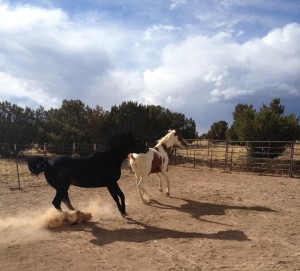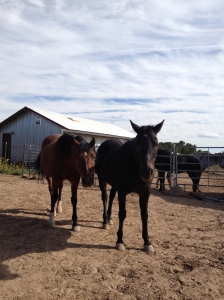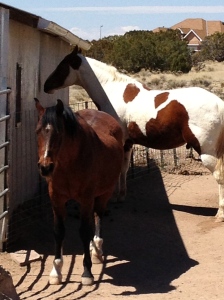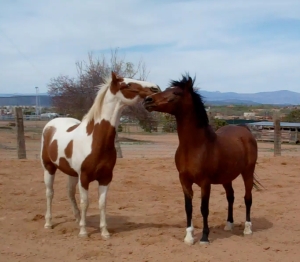Will they like each other? Will someone get his lights punched out? What’s going to happen?

Integrating new members into your herd of horses can be an interesting time. Recently I moved our gelding Patches in with our 24-year-old gelding Khami and 21-year-old mare, Zuzka. These two have been friends forever and I had been hesitant to bring Patches into the fold for a couple of reasons. One, he is big and the day time space is big enough for all three, but the night time space is a little cramped. We don’t have acres of pasture, just your basic New Mexico dirt lots and arenas.
Patches had been getting aggressive with an older horse who had suffered a head injury. I’ve read that in a herd, horses may ostracize a horse that is “not right in the head.” It is a survival of the fittest activity, to keep the herd healthy and intact and to weed out any instability that might endanger the herd.
I’d always thought Patches wasn’t completely at home with the two older horses he lived with, but I liked the fact that he had physical space in their corral. I didn’t like what I was seeing when he began harassing the sick horse. It impacted my training with Patches to have him turn aggressive like this. He has always been a very quiet horse and low man on the totem pole. I need him to be quiet because he is a wonderful horse for the grandchildren to ride. In that herd, he stood apart from the others most of the time.
Immediately after I moved him in with Khami and Zuzka, he shifted back to his polite self. He did get pushed around a bit by them in the beginning, a few bites and scratches, mostly from the mare. He stood apart from them, quietly sharing territory. Khami enjoys having Patches to play with because he loves having another boy around who likes to play games like “Bite my Face.” Of course, both of them have some fur missing because of this but I don’t care because it makes them happy and fun to watch, and it’s relatively harmless.
Making these changes in my herd makes my training easier. The herd takes care of behaviors that are unacceptable without my having to do it. I remember a trainer telling me years ago that moving my mare in with Khami made her life easier because my mare was managed by him. That way the trainer didn’t have to work so hard to train the mare because Khami was doing a large part of the work.
These situations don’t always work out so amicably. You have to assess the quality of the relationships between the horses, because like us, they like some horses better than others. Some combinations just don’t work. Space also has a lot to do with it. If you don’t have a lot of space, then it’s more important that they get along well. They can work out a lot of disagreements more easily in a larger space with more to interest them.
What Khami does so beautifully is lead everybody from behind. He needs to be led from behind himself sometimes as he can get overly bossy, but he makes sure there is order in the group. Putting Patches in with Khami and Zuzka has also given Zuzka something else to do – she leads him from behind too and goes after him if he stands in the wrong place. It gives Khami a break because he doesn’t have to do all the work.
Things are still shifting in this small herd of three. I noticed the other day that Patches had a new bit of hair missing from his hindquarters. And then I noticed he was standing sleeping in Zuzka’s favorite spot. She was off gazing at the cows in the adjacent pasture. She has always pushed Patches off that spot with vehemence. When I went to greet Patches, Zuzka came over to say hello to me. She greeted him too very politely. She still did not make any faces at him or push him away.
Patches is looking increasingly comfortable with the two old friends and he doesn’t look so “apart” from them now. Of course he stands out because he’s a big bright Paint and they are little brown Arabs. But I catch him and Khami sharing a hay bag, or sleeping companionably side by side.
This also gives me more opportunities to observe herd behavior. Even if horses don’t live in a big herd, the same rules apply. It is these rules that we use in the Horses at Liberty Foundation work. These small interactions may seem funny to us but they mean the world to horses. They are how they live and survive.
This is what I teach in the Liberty Foundation Training Clinics. See the following blog to find out what we may do in the upcoming May 26th clinic.
Santa Fe Spring Clinic Builds the Working Bond with Horses
(copyright Susan Smith)
Bodywork: private sessions, tutorials, phone consultations, distance healing and gift certificates
Liberty Training: clinics, workshops, private sessions, tutorials, consultations: by appointment: 505.501.2478 or emailing susansmith@orthohorse.info
My upcoming Horses at Liberty Foundation Clinic will be held May 26 in Santa Fe. Cost is $150. Contact me if interested! susansmith@orthohorse.info





This topic is always relevant! So happy that your three have worked out their differences. Just watching horses interact is a whole Waterhole Rituals lesson in itself!